Related Research Articles

António Manoel de Vilhena was a Portuguese nobleman who was the 66th Prince and Grand Master of the Order of St. John of Jerusalem from 19 June 1722 to his death in 1736. Unlike a number of the other Grand Masters, he was benevolent and popular with the Maltese people. Vilhena is mostly remembered for the founding of Floriana, the construction of Fort Manoel and the Manoel Theatre, and the renovation of the city of Mdina.
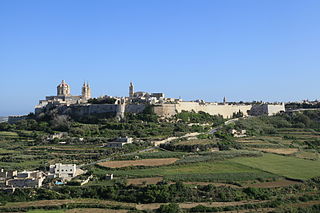
Mdina, also known by its Italian-language titles Città Vecchia and Città Notabile, is a fortified city in the Northern Region of Malta which served as the island's capital from antiquity to the medieval period. The city is still confined within its walls, and has a population of just under 300, but it is contiguous with the town of Rabat, which takes its name from the Arabic word for suburb, and has a population of over 11,000.

The Archdiocese of Malta is a metropolitan archdiocese of the Latin Rite of the Catholic Church in Malta.

Maltese architecture has its origins in prehistory, and some of the oldest free-standing structures on Earth – a series of megalithic temples – can be found on Malta. The islands were colonized by the Phoenicians and later the Romans, who established the cities of Melite and Gaulos. Although these were substantial settlements and are known to have had numerous temples, churches and palaces, few remains have survived apart from some architectural fragments.

The Metropolitan Cathedral of Saint Paul, commonly known as St Paul's Cathedral or the Mdina Cathedral, is a Roman Catholic cathedral in Mdina, Malta, dedicated to St. Paul the Apostle. The cathedral was founded in the 12th century, and according to tradition it stands on the site of where Roman governor Publius met St. Paul following his shipwreck on Malta. The original cathedral was severely damaged in the 1693 Sicily earthquake, so it was dismantled and rebuilt in the Baroque style to a design of the Maltese architect Lorenzo Gafà between 1696 and 1705. The cathedral is regarded as Gafà's masterpiece.

Lorenzo Gafà (1639–1703) was a Maltese Baroque architect and sculptor. He designed many churches in the Maltese Islands, including St. Paul's Cathedral in Mdina and the Cathedral of the Assumption in Victoria, Gozo. He was the younger brother of the sculptor Melchiorre Cafà.
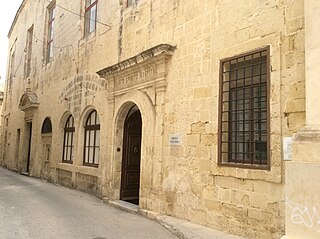
The National Archives of Malta is the central archive maintained by the Mediterranean island nation of Malta. The Archives has been housed in the Grandmaster's Palace for most of its lifetime, having moved to three separate locations during the late 1980s. In 1988, the Legal Documentation Section of the National Archives of Malta was opened, after records of court and tribunal hearings and decisions had been transferred to a Mdina facility beginning the previous year. A Gozo facility was opened soon after, and in 1994, the then-President of Malta, Ugo Mifsud Bonnici, officially opened the Archives' new Rabat head office and main facility. All of the Archives' locations feature a reading room, with facilities for researchers open to those over the age of sixteen who produce valid identification.

The Invasion of Gozo took place in July 1551, and was accomplished by the Ottoman Empire against the island of Gozo, following an unsuccessful attempt to conquer nearby Malta on 18 July 1551. It was followed by a victorious campaign with the siege of Tripoli.
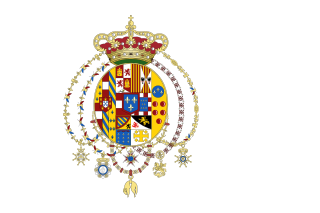
The Gozitan Nation, commonly known as Gozo, was an unrecognised state located on the island of Gozo between 1798 and 1801 during the French Revolutionary Wars. It was a monarchy ruled by King Ferdinand III of Sicily with a provisional government led by Governor-general Saverio Cassar. Its capital was Rabat. The country was established between 28 and 29 October 1798 from the territory of French-occupied Malta and was eventually incorporated into Malta Protectorate on 20 August 1801.

Hospitaller Malta, known within Maltese history as the Knights' Period, existed between 1530 and 1798 when the Mediterranean islands of Malta and Gozo were ruled by the Order of St. John of Jerusalem. The polity was formally a vassal state of the Kingdom of Sicily, and it came into being when Emperor Charles V granted the islands as well as the city of Tripoli in modern Libya to the Order, following the latter's loss of Rhodes in 1522. Hospitaller Tripoli was lost to the Ottoman Empire in 1551, but an Ottoman attempt to take Malta in 1565 failed.

There are hundreds of catacombs in Malta, principally found in Mdina, the former capital of the island. The catacombs are very small, but are in good preservation.
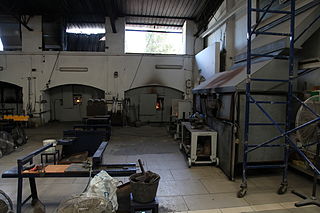
Mdina Glass is a manufacturer of glassware, based in Malta. It was founded in 1968 by Michael Harris, a lecturer in industrial glass design at the Royal College of Art. Attracted by various government incentives offered by newly independent Malta, Eric Dobson and Michael Harris ventured out to Mediterranean island from the UK with the aim of opening Malta's first ever glassware manufacturer. The company, Maltese Glass Industries, became an active glassmaking company in 1968. Mdina Glass was an instant success and soon the company was taking on local trainees to learn the craft. One of these trainees was Joseph Said, quickly impressing Harris and Dobson with his natural abilities in glassmaking. In 1971, two Italian maestros, the father and son team of Vincente and Ettore Boffo joined Mdina Glass to introduce Italian glassmaking techniques. Following independence from the UK in 1964, the Maltese government offered incentives for skilled workers and entrepreneurs from outside the island, in order to build up the industrial and commercial sectors of the economy. This included a 10-year tax holiday. Due to personal reasons, Harris left Mdina Glass in 1973, leaving Eric Dobson alone at the helm and by 1975, once promising trainee Joseph Said had climbed the ranks to become the company's Production Manager, acting as a catalyst for a number of changes, revolutionising the way the company operated and what it produced. At the end of 1967 Harris and Eric Dobson, another lecturer from the RCA, imported glassmaking equipment to Malta, and set up Maltese Glass Industries. In 1985 Eric Dobson chose to relinquish control of Mdina Glass and return to the UK. The company wasn't doing as well as it had done in previous years. Joseph Said took over and, under his control, the company went through some quick changes to remedy the commercial situation in challenging times. Said's influence was evident by 1987 when Mdina Glass won the International Award for Tradition and Prestige in Brussels. Two years later, Mdina Glass presented a glass sculpture to the Maltese Prime Minister to commemorate the Bush – Gorbechev Malta summit. In 1992, the company won the Malta Achievement in Industry Award.

The fortifications of Malta consist of a number of walled cities, citadels, forts, towers, batteries, redoubts, entrenchments and pillboxes. The fortifications were built over thousands of years, from around 1450 BC to the mid-20th century, and they are a result of the Maltese islands' strategic position and natural harbours, which have made them very desirable for various powers.
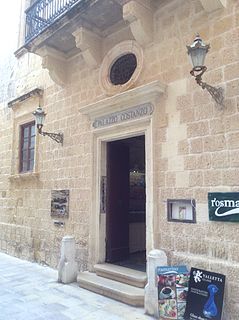
Palazzo Costanzo is a palace in Mdina, Malta, situated on Villegaignon Street. It was formerly the residence of a noble Sicilian family, having been constructed in 1666 by Tomaso Costanzo. The building was later converted into a restaurant. It also hosts the Medieval Times Show, which provides an insight into local life in the 14th and 15th centuries.

The Banca Giuratale, also known as the Municipal Palace, is a public building in Mdina, Malta. It was built in the 18th century to house the city's administrative council and courts, and was later used as a private residence and a school. It now houses part of the National Archives of Malta.
Saverio Cassar was a Gozitan priest and patriot, who was Governor-general of an independent Gozo from 1798 to 1801.

Ħalfa Rock(Maltese: Il-Ġebla tal-Ħalfaor Il-Blata tal-Ħalfa) is a deserted small islet and limestone rock on the south-east coast of the island of Gozo in the Maltese archipelago. The small islet is typified by a small maritime labiate garrigue environment, with germander and prasium shrubs, with the occurrence of the endemic Maltese Pyramidal Orchid as well as endemic coastal communities based on the Maltese Sea-Lavender and the sub-endemic Maltese Crosswort.
Seismic risk in Malta is considered to be low with little historic damage noted and no known victims. The archipelago is however in a potentially significant seismic zone and the risk to the population is probably undervalued.

The Gozo Phoenician shipwreck is a seventh-century-BC shipwreck of a Phoenician trade ship lying at a depth of 110 meters (360 ft). The wreck was discovered in 2007 by a team of French scientists during a sonar survey off the coast of Malta's Gozo island. The Gozo shipwreck archaeological excavation is the first maritime archaeological survey to explore shipwrecks beyond a depth of 100 meters (330 ft).
References
- ↑ "Retro Glass - Maltese retro/vintage mid-century modern design". Pips-trip.co.uk. Retrieved 9 May 2010.
- ↑ "Mdina Glass, Malta 1968". Burgh-Le-Marsh Furnishings. Archived from the original on 19 November 2009. Retrieved 9 May 2010.